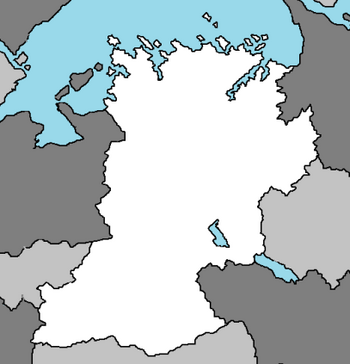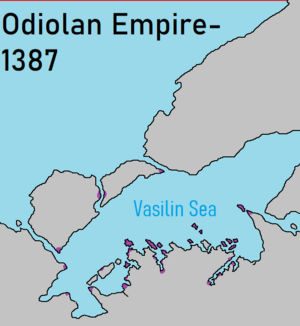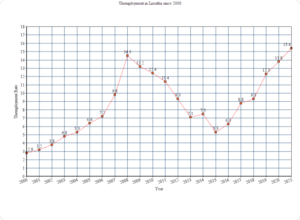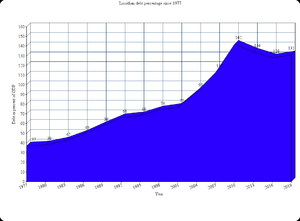Lissatha
Republic of Lissatha Demokratia dou Lisátha | |
|---|---|
| Motto: Unosi, Forzami, kai Libertheria Union, Strength, and Liberty | |
| Anthem: Innos to Libertheria (Hymn to Liberty) | |
 | |
| Capital and largest city | Odiola |
| Official languages | Lissathan |
| Ethnic groups | Raguran 45% Kryotirian 43% |
| Religion | Catholic 45% Orthodox Christian 43% |
| Demonym(s) | Lissathan |
| Government | Federal Presidential Constitutional Republic |
| Klaudio Angela | |
| Xaviero Mazzeo | |
• Senate Majority Leader | Stephanos Michelakis |
• President of the Chamber | Luigina Caito |
| Legislature | Delaïkó |
| Senate | |
| Chamber of Representatives | |
| Establishment | |
• The Lissathan Wedding | 1664 |
| June 3, 1851 | |
| Area | |
• Total | 500,699 km2 (193,321 sq mi) |
• Water (%) | 6.12 |
| Population | |
• 2020 estimate | 65,500,000 |
• Density | 130.8/km2 (338.8/sq mi) |
| GDP (nominal) | estimate |
• Total | $528.434 billion |
• Per capita | $13,465 |
| Gini (2020) | 34.6 medium |
| HDI (2020) | 0.903 very high |
| Currency | Dollario |
| Time zone | UTC +7 |
The Republic of Lissatha (Lissathan: Demokratia dou Lisátha) is a country located in north east Euronia, it's population is approximately 75.5 million as of 2018, Odiola is it's capital and largest city with a population of 2.3 million, followed by Gakretta.
Ancient Lissathan city states are known for their beautiful architecture and their advances in human thought, with the Lissathan Golden Age lasting from the 4th century BC to the 2nd century BC, and ended after a 37 year war between the city states of Odiola and Brissarta which nearly destroyed the two cities and devastated the city states along the coastline. In the 900s to 1500s Odiola created a vast trade empire before eventually collapsing, a royal marriage in 1664 created modern day Lissatha. The monarchy ruled for centuries before the June 3 1851 Revolution where members of the Republican-Federalist Party overthrew King Benito.
Lissatha is a Federal Presidential Constitutional Republic and a developed nation.
Etymology
The name Lissatha means beautiful sea.
History
Prehistory
Ancient Lissathan city states are known for their beautiful architecture and their advances in human thought, with the Lissathan Golden Age lasting from the 4th century BC to the 2nd century BC, and ended after a 37 year war between the city states of Odiola and Brissarta which nearly destroyed the two cities and devastated the city states along the coastline.
Odiolan Empire
At some point during the early 10th century a man named Aetius overthrew the democratically elected government of Odiola and proclaimed himself King, Odiola had gone through a centuries long decline by that point but Aetius sought to build an empire, by the year 1000 AD Aetius and his successors had conquered several coastal cities in modern day Lissatha, including Livotasa, Brissarta, Portopesia and others.
Orthodox Christianity came to Lissatha in the 1100s, and a series of religious wars were fought before the signing of the Treaty of Odiola.
The Odiolan Empire reached it's peak in 1387, controlling the majority of access points to the Vasilin sea. The Odiolan Empire would dominate trade in the Northern Ocean for the next few centuries.
In 1392 Aetius VI died without an heir, sparking a war between Alexander VIII and Sofoklis II, Alexander dominated most of the war, but his death from disease in 1399 allowed Sofoklis to claim the throne, this is commonly seen as the end of the Odiolan golden age. In the mid 1400s Odiola lost a series of wars, losing massive ammounts of land, triggering a civil war which caused the collapse of the Odiolan Epmire.
Monarchy Era
In 1664 King Alexander of Odiola married Queen Francesca of Portopesia, uniting the two kingdoms and creating modern day Lissatha. At the time the Kingdom was mainly confined to the coastline. The reign of Agapitos II lead to attempts to colonize the countries south. By 1750 Lissatha had reestablished itself as an important figure in trade in the region.
By the mid 1800s Lissatha had once again fallen on hard times, the economy was struggling and people were struggling to make it by while the royal family continued living in luxury, in 1842 while King Alfonso was riding in a carriage a man threw a bomb at the carriage, which killed Alfonso and his guards.
Revolution and Civil War
In 1842 MP Dimitrios Ferrari and a group of like minded individuals presented the Declaration of Rights to King Benito, which would've significantly limited his powers, Benito rejected this proposal and had Ferrari arrested, causing mass protest. In 1851 after years of anti-monarchist sentiment members of the recently formed Republican-Federalist Party, led by Giorgio Antonopoulos lead a coup against King Benito, a provisional government being set up with an amended version of the Declaration of Rights being put in place as the constitution. On June 14 King Benito was freed by a guard with monarchist sentiments and fled south to Gakretta, a civil war raged in Lissatha for the next 5 years before Benito was captured and arrested in 1856.
In 1856 after the end of the civil war revolutionary leaders met in Odiola to write the Constitution of Lissatha, after 7 months the constitution was ratified on December 19, 1856.
Modern Period
In the 1936 Lissathan presidential election Appolon Pachis won in a landslide, Pachis would serve as president for five terms from 1936 until his death from a stroke in 1961.
World War
In 1949 Drambenburg invaded Avergnon, starting the World War, Pachis issued an official condemnation of Drambenburg's actions.
On October 19, 1950 Drambenburg bombed the city of Titania, killing over 9,000 civilians, in response Lissatha placed an embargo on Drambenburg.On June 15 Dominion of the Sanguine Church(DSC) invaded Avergnon and joined forces with Drambenburg, forming the League Powers. By June 24th the Delaïkó voted to declare war on Drambenburg and DSC, with Lissatha joining the Allied Powers.
Shortly after Lissathan forces were sent south to assist in Avergnon, helping beat back Drambenburgian and DSC forces, in 1954 Lissatha participated in the allied landings in Drambenburg. Overall a total of 573,243 Lissathans served in the World War, with 82,359 deaths. Despite the high death toll Pachis decision to enter the war was incredibly popular and made major boosts to the economy.
1960s and onwards
He would be succeeded by his Vice President Diego Monaldo, who was only 43 at the time and very inexperienced, having served just 4 years in the Senate before being chosen as vice president. Monaldo inherited a strong economy and rode that to re-election in 1962, but the economy crashed in 1964, leading to him losing in a landslide in 1966 to Nerio Iordanou, Nerio managed to bring the economy back to normal levels and passed the 6th amendment, setting a two term limit.
In 1980 President Apostolos Romanos was assassinated, his Vice President Ivo Leone lost the 1982 election and was later convicted for attempted electoral fraud. Romanos, a Raguran, was assassinated by Ignatios Salellis, a Kryotirian, this would end up sparking the 1980 Lissathan Riots and mass unrest that would only be tamed by the success of the Lissatha national football team in the 1980 Turania World Cup.
Over the 2000s the economy boomed and spending increased during the presidency of Akakios Bondesan but the economy crashed in 2008, leading to a massive debt crisis.
Geography
Lissatha is located in Northeastern Euronia, and covers an area of 423,000 km2 (163,320 mi2). Lissatha has about 168,000 lakes (of area larger than 500 m2 or 0.12 acres) and 179,000 islands. Its largest lake, -insert name-, is the tenth largest in Euronia. The Southern Lissathan Lakeland is the area with the most lakes in the country; many of the major cities in Lissatha, most notably Odiolan, Brissarta and Portopesia, are located in the immediate vicinity of the coast. The greatest concentration of islands is found in the north, in the Lissathan Archipelago in the Vasilin Sea. Much of the geography of Lissatha is a result of the Ice Age. The glaciers were thicker and lasted longer in Lissatha compared with the rest of Euronia. Their eroding effects have left the Lissatha landscape mostly flat with few hills and fewer mountains. Its highest point, Picgranfí at 1,324 metres (4,344 ft), is found in the extreme southwest border with South Kandson. The highest mountain whose peak is entirely in Lissatha is Lóthón at 1,316 m (4,318 ft), directly adjacent to Olimpos.
There are some 187,888 lakes in Lissatha larger than 500 square metres and 75,818 islands of over 0,5 km2 area, leading to the denomination "the land of a hundred thousand lakes". The retreating glaciers have left the land with morainic deposits in formations of eskers. These are ridges of stratified gravel and sand, running northwest to southeast, where the ancient edge of the glacier once lay. Among the biggest of these are the three Infater ridges that run across northern Lissatha in the divide between the much more fertile southern region. Having been compressed under the enormous weight of the glaciers, terrain in Lissatha is rising due to the post-glacial rebound. The effect is strongest around Esaset Bay (shared with North Kandson), where land steadily rises about 1 cm (0.4 in) a year. As a result, the old sea bottom turns little by little into dry land: the surface area of the country is expanding by about 7 square kilometres (2.7 sq mi) annually. Relatively speaking, Lissatha is rising from the sea.
The northern landscape is covered mostly by coniferous taiga forests and fens, with little cultivated land. Of the total area 6% is lakes, rivers and ponds, roughly 25% agriculturally distinct, and 68% forest. The forest consists of pine, spruce, birch, and other species. Lissatha is the fifth largest producer of wood in Euronia and among the largest in the world. The most common type of rock is granite. It is a ubiquitous part of the scenery, visible wherever there is no soil cover. Moraine or till is the most common type of soil, covered by a thin layer of humus of biological origin. Podzol profile development is seen in most forest soils except where drainage is poor. Gleysols and peat bogs occupy poorly drained areas.
Biodiversity
The territory of Lissatha can be subdivided into three ecoregions: the Lissatha taiga, Kandson mixed forests, and Kandson Montane Birch forest and grasslands. Taiga covers most of Lissatha from northern regions to the midlands. On the northern coast, forests are characterized by mixed forests, that are more typical in the Vasilin Sea region. Similarly, Lissatha has a diverse and extensive range of fauna. There are at least sixty native mammalian species, 248 breeding bird species, over 70 fish species, and 11 reptile and frog species present today, many migrating from neighboring countries thousands of years ago. Large and widely recognized wildlife mammals found in Lissatha are the brown bear, gray wolf, wolverine, and elk.
Three of the more striking birds are the Euronian swan; the Western capercaillie, a large, black-plumaged member of the grouse family; and the Euronian eagle-owl. The latter is considered an indicator of old-growth forest connectivity, and has been declining because of landscape fragmentation. Around 24,000 species of Insects are prevalent in Lissatha some of the most common being hornets with tribes of beetles such as the Onciderini also being common. The most common breeding birds are the willow warbler, common chaffinch, and redwing. Of some seventy species of freshwater fish, the northern pike, perch, and others are plentiful. Northern salmon remains the favourite of fly rod enthusiasts. The national animal is the Northern white-sided dolphin, which is one of two dolphin species in the Northern Ocean and its subseas, the other being the killer whale.
The endangered Livotasa ringed seal, one of only three lake seal species in the world, exists only in the coastal inlet system of northwestern Lissatha, down to only 390 seals today. The Livotasa ringed seal has become the emblem of the Lissathan Association for Nature Conservation. The Livotasa ringed seal lives nowadays mainly in conservation areas, but strays have been seen in a much larger area, including near Livotasa's city centre.
Climate
The main factor influencing Lissatha's climate is the country's northern geographical position in Euronia's northern coastal zone. In the Köppen climate classification, the whole of Lissatha lies in the boreal zone, characterized by warm summers and freezing winters. Within the country, the temperateness varies considerably between the southern interior regions and the extreme coastal north, showing characteristics of both a maritime and a continental climate. Lissatha is far enough away from the Samson Ocean that it is not continuously warmed by a gulf stream. However, the coast does have more mild winters due to its lower elevation.
Winters in southern Lissatha (when mean daily temperature remains below 0 °C or 32 °F) are usually about 100 days long, and in the inland the snow typically covers the land from about late November to April, and on the coastal areas snow often covers the land from late December to late March. Even in the south, the harshest winter nights can see the temperatures fall to −30 °C (−22 °F) although on coastal areas temperatures below −30 °C (−22 °F) are rare. Climatic summers (when mean daily temperature remains above 10 °C or 50 °F) in southern Lissatha last from about late May to mid-September, and in the inland, the warmest days of July can reach over 35 °C (95 °F). Although most of Lissatha lies on the taiga belt, the southernmost coastal regions are sometimes classified as hemiboreal.
The Lissatha climate is suitable for farming mainly in the southernmost regions, while the northern regions are suitable for animal husbandry and some cereal farming.
Politics
Lissatha is a federal republic of 12 states. It is a federal republic and representative democracy. In the Lissathan federalist system, citizens are usually subject to three levels of government: federal, state, and local. The local government's duties are commonly split between county and municipal governments. In almost all cases, executive and legislative officials are elected by a plurality vote of citizens by district.
The federal government comprises three branches:
- Legislative: The bicameral Delaïkó, made up of the Senate and the Chamber of Representatives, makes federal law, declares war, approves treaties, has the power of the purse, and has the power of impeachment, by which it can remove sitting members of the government.
- Executive: The president is the commander-in-chief of the military, can veto legislative bills before they become law (subject to Delaïkó override), and appoints the members of the Cabinet (subject to Senate approval) and other officers, who administer and enforce federal laws and policies.
- Judicial: The Supreme Court and lower federal courts, whose judges are appointed by the president with Senate approval, interpret laws and overturn those they find unconstitutional.
The Chamber of Representatives has 253 voting members, each representing a county for a two-year term. Chamber seats are apportioned among the states by population.
The Senate has 48 members with each state having four senators, elected at large to 8 year terms; one-fourth of Senate seats are up for election every two years. The president serves a four-year term and may be elected to the office no more than twice. The president is not elected by direct vote, but by an indirect electoral college system in which the determining votes are apportioned to the states. The Supreme Court has 7 members who serve for life.
Political Divisions
The 12 states are the principal political divisions in the country. Each state holds jurisdiction over a defined geographic territory, where it shares sovereignty with the federal government. They are subdivided into counties or county equivalents and further divided into municipalities. The states choose the president of the Lissatha. Each state has presidential electors equal to the number of their representatives and senators in the Delaïkó.
Parties and Elections
Lissatha has operated under a two-party system for most of its history. For elective offices at most levels, state-administered primary elections choose the major party nominees for subsequent general elections. The Republican-Federalist Party has been the dominant conservative party since the 1938 election, with the major liberal parties cycling between New Democracy (1938-1986), Liberal-Conservative (1988-2010), and currently Popular Unity.
In the 41st Lissathan Delaïkó, the Chamber of Representatives and the Senate are controlled by Popular Unity. The senate consists of 14 Popular Unitists and 10 Federal-Republicans; the chamber consists of 135 Popular Unitists and 118 Federal-Republicans. Of state governors, there are 7 Federal-Republicans and 5 Popular Unitists.
Foreign Relations
Lissatha is a member of the Coalition of Crown Albatross, joining shortly after it's founding.
Government Finance
Taxation in Lissatha is progressive, and is levied at the federal, state, and local government levels. This includes taxes on income, payroll, property, sales, imports, estates, and gifts, as well as various fees.
In 2010 taxes collected by federal, state and municipal governments amounted to 22.8% of GDP. For 2018, the effective tax rate for the wealthiest 400 households was 22%, compared to 23.2% for the bottom half of Lissathan households.
Military
The president is the commander-in-chief of the Lissathan Armed Forces and appoints its leaders, the minister of defense and the Joint Chiefs of Staff. The Ministry of Defense administers four of the five service branches, which are made up of the Army, Marine Corps, Navy, and Air Force. Lissatha maintains the Lissathan Coast Guard for law enforcement at sea, search and rescue, and port operations. Though it can support the navy during wartime, it resides under the authority of the Ministry of Shipping.
Military service in Lissatha is voluntary, although conscription may occur in wartime through a draft.
Economy
The economy of Lissatha is the 26th largest by nominal gross domestic product at 668.5 billion with a GDP per capita of $16,973 per person. The Lissathan economy is classified as advanced and high income, since 2018 it has been going through a recession and went through another recession in 2008, despite this it is one of the strongest economies in northeast Euronia. Lissatha has a capitalist mixed economy.
Lissatha is a developed country with a high standard of living and a high ranking in the Human Development Index. Its economy mainly comprises the service sector (85.0%) and industry (12.0%), while agriculture makes up 3.0% of the national economic output. Important Lissathan industries include tourism (With 22.8 million international tourists in 2020 it is one of the most visited countries in the world) and merchant shipping, the countries south is heavily agricultural.
Lissathan unemployment stood at 15.4% in October 2021, with a youth unemployment rate of 36.7%.
Lissatha is the largest economy in northeast Euronia.
Debt Crisis (2008-2015)
The Lissathan economy fared well for most of the 20th century, with high growth rates and low public debt. The debt crisis was triggered by the fiscal policies of President Moreno Napoliello and his so called "meronomics", which advocated for supply side economics, with tax cuts and increased spending at the same time.
By 2015 it seemed that the worst of the crisis was over, though there was a brief rise in 2019.






